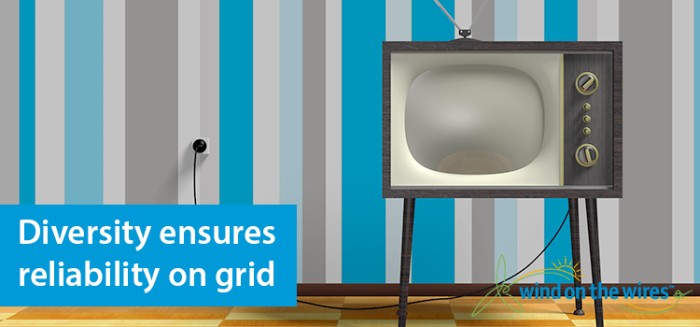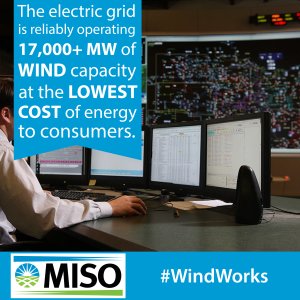Just Smart: Diversity on our electric grid ensures reliability and low costs
 | Kelley Welf, Communications Director |

 | Kelley Welf, Communications Director |
Why would we want to stay tethered to old technology, like switching a television set on with a knob, when modern technology offers plug-and-play flexibility at a low price?
It seems like everything in our lives these days can be customized. We all have our own phone numbers, set our personal preferences for temperature in the car between the driver and passenger side, front seat and back seat, not to mention fully adjustable seats and heated steering wheels. We have thermostats that can adjust the temperature in our homes based on our preferences and schedules – which we can further manipulate remotely from our phones. Personalized music playlists and favorite radio and TV stations are at our fingertips. Ergonomics rule our office culture with specialized desktop keyboards, office chairs, convertible stand-up desks, and ear buds can take the pain out of our necks during conference calls. We can even get vanity license plates for our car. The list goes on and on.
So, why is it so hard to imagine our energy system doing the same thing? Indeed, our power system has evolved from using inflexible, large power plants to harnessing a multitude of sources that offer energy security and cost effectiveness. Many large corporations are choosing to power their operations with renewable energy. There are a growing number of opportunities for people to power their lives with renewables through various utility programs; and products like the Tesla Powerwall enable homeowners to store solar power generated on their roofs. But, everyone is already benefiting from our existing electric grid. Regional Transmission Organizations (RTOs or ‘grid operators’) customize our energy resources every day by selecting generation from a pool of resources, including the growing variety of renewable resources that are currently on the system. Gone are the one-size-fits-all days of only a couple sources of generation, which leaves our system – and economy – vulnerable.
Diversity in our electric grid is the key. It not only improves reliability, but also guarantees we’re getting the lowest-cost resources at all times. The Midcontinent Independent System Operator (MISO) is the grid operator for the central portion of the country. MISO, and its sister RTOs like PJM, SPP, ERCOT, and others select from their stack of resources in least-cost order until the demand is met. Often, wind is the lowest price because it has no fuel cost compared to other resources. You can see that having more low-cost energy on the system truly does help keep our electric rates down.
Our Regional Integrated Electric Grid offers all the back-up we need

Yet, many people think because renewable resources like wind and solar are variable, back-up generation is required (and that would inevitably increase costs). The fact is that no resource is available 100 percent of the time. Grid operators have reserves available to keep our lights on – and our economy running – all day, every day. The nation’s network of transmission lines and integrated regional electric system enables grid operators to draw upon resources from across their footprint to meet demand. The beauty of our electric system is that it is inherently designed to provide all the back-up generation we need while using the least-cost resources to do so.
Diversity of generation resources is also vital for reliability. A good retirement planner recommends a diverse portfolio so that if one investment goes down, other assets that are moving up in the market can offset any losses you might experience. The same concept applies to our electric grid. In this way, back-up has always been, and always will be, built into our system.
Furthermore, our regional electric grid operators are pros at the delicate balancing act that is required to meet supply and demand on a moment-by-moment basis. And, because of technological advancements in forecasting and the gradual nature of the changes in wind output, grid operators are able to easily accommodate the variability of renewable resources. The MISO system successfully manages more than 17,000 megawatts of wind capacity, and on January 17, 2018, reached an historic wind peak of 15,038 megawatts on the system. An RTO’s diverse geographical footprint also helps reduce the need for additional assets for capacity reserves because resources can be shared. After all, the wind is always blowing somewhere!
Subscribe to our newsletter for the latest on energy & our work
As wind continues its dramatic decline in cost, utilities are beginning to think of wind as the new baseload resource, and other flexible lower-cost resources like natural gas can be used to fill the gaps. A year ago, David Saggau, CEO of Great River Energy said, “I would suggest to you that wind is quickly becoming the new baseload; and to be viable going forward, all other sources must be flexible enough to be supplemental to the wind.”
In our modern age of maximum flexibility and plug-and-play technology, why would we want to stay tethered to our old rigid sources of energy? Today’s wind energy is a low-cost leader and diversifies our electric grid; and that helps keep our lights on 24-7.
Wind energy. It’s just smart.
Learn more about this topic here.
Want to learn more about renewable energy? Sign up for our monthly "Renewable Champions" newsletter to get the latest stories and resources about the Midwest's transition to renewable energy.